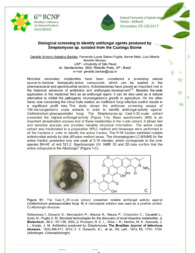Biological screening to identify antifungal agents produced by Streptomyces sp. isolated from the Caatinga Biome.
Biological screening to identify antifungal agents produced by Streptomyces sp. isolated from the Caatinga Biome.
Author(s): BARBÃO, G. A. A.; FUGITA, F. L. S.; MELO, I. S. de; MORAES, L. A. B.
Summary: Microbial secondary metabolites have been considered a promising natural source to disclose biologically active compounds, which can be applied in the pharmaceutical and agroindustrial sectors. Actinobacterias have played an important role in the historical advances of antibiotics and antifungals development1,2. Besides the wide application in the medicinal field as an antifungal agent, it can be also used as a natural alternative to inhibit the pathogenic microorganism?s growth in agriculture. On the other hand, now concerning the citrus fruits market, an inefficient fungi infection control results in a significant profit loss. This study shows the antibiosis screening assays of 196 microorganism?s crude extracts in order to identify antifungal activity against Colletotrichum gloeosporioides fungi. The Streptomyces sp. Caat 5-35 crude extract presented the highest antifungal activity (Figure 1-A). Mass spectrometry (MS) is an important dereplication process tool of these metabolites in the crude extract. It allows fast and sensitive analysis and provides valuable structural information. The active crude extract was fractionated in a preparative HPLC method and bioassays were performed in all the fractions in order to identify the active fraction. The Fr16 fraction exhibited notable antimicrobial activity by disk diffusion method assay. The chromatogram LC-MS/MS for the active fraction presented only one peak at 5.16 minutes, which corresponds to the ionic species [M+H]+ of m/z 521.2. Spectroscopic UV, NMR 1D and 2D data confirm that the active compound is the Albofungin3.
Publication year: 2017
Types of publication: Abstract in annals or event proceedings
Unit: Embrapa Environment
Keywords: Fungo, Streptomyces
Observation
Some of Embrapa's publications are published as ePub files. To read them, use or download one of the following free software options to your computer or mobile device. Android: Google Play Books; IOS: iBooks; Windows and Linux: Calibre.
Access other publications
Access the Agricultural Research Database (BDPA) to consult Embrapa's full library collection and records.
Visit Embrapa Bookstore to purchase books and other publications sold by Embrapa.

